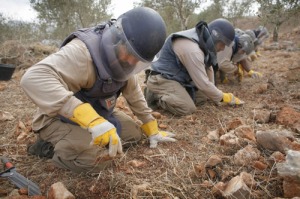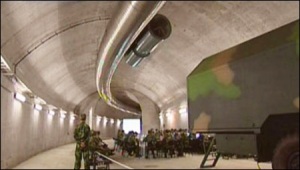Xiaodon Liang
Although the value of its arms sales agreements dipped slightly in 2010, the United States registered a marked increase in its share of the global arms trade as spending on imported conventional weapons systems dropped sharply worldwide, according to a recently released Congressional Research Service report.
Richard Grimmett, the author of “Conventional Arms Transfers to Developing Nations, 2003-2010,” found that the United States concluded arms sales agreements worth $21.3 billion in calendar year 2010, compared to $22.6 billion in 2009. The total value of world conventional weapons sales agreements dropped from $65.2 billion to $40.4 billion over the same period. As a result, the U.S. share rose from 34.7 percent to 52.7 percent.
The report, the latest in a series of annual analyses published since 1982, is based on unclassified U.S. government sources. It cites the “tenuous state of the global economy” as the leading cause of the significant fall in the total value of arms sales. Grimmett says that competition among major arms suppliers has become “increasingly intense” as each expands beyond traditional customers. Domestic economic concerns now motivate arms-supplier policy “as much, if not more” than foreign policy considerations, the report says.
The majority share of the market commanded by the United States is significantly higher than the country’s 38.6 percent average share over the eight-year period covered by the report. High-value agreements concluded last year by the United States include the sale to Israel of 19 F-35 Joint Strike Fighter aircraft for $2.8 billion and the sale of 60 UH-60M Black Hawk helicopters to Taiwan for $2.4 billion.
As in previous years, Grimmett emphasizes that follow-on parts and ammunition sales, upgrades, and support services constitute a large part of the total U.S. export figure. In 2010, Saudi Arabia signed contracts for support and spare parts for Abrams M1A2 and M1AS tanks worth $384 million and contracts for F-15 combat aircraft worth $230 million. Pakistan paid $220 million for midlife upgrades for its F-16 aircraft, while India purchased CBU-105 Sensor Fuzed Weapons, a type of cluster munition, for $384 million.
Russia retained a 19.3 percent share of the market, down slightly from 19.6 percent in the previous year despite a sharp drop in the value of its concluded agreements from $12.8 billion to $7.8 billion. The average value of annual Russian sales agreements over the past eight years was $10.1 billion.
The largest agreements concluded by Russia in 2010 were for the sale to India of 29 MiG-29K combat aircraft worth $1.5 billion and the sales to Algeria of 16 Su-30MKI fighters and to Uganda of five Su-30MK2 fighters, worth at least a collective $1.2 billion.
Although Russia and the United States were able to maintain their positions as leading arms suppliers, major European exporters suffered. The combined value of all arms export agreements signed by France, Germany, Italy, and the United Kingdom fell from $17.1 billion in 2009 to $4.6 billion in 2010. In terms of market share, those four states’ deals constituted only 11.4 percent of global export agreements, well below their eight-year average of 23.7 percent.
According to Grimmett, each of the main European exporters has experienced occasional years of strong sales, usually as the result of large contracts with a single arms buyer or a small number of major purchasers in one year. However, actual deliveries by the four states have continuously declined since 2003, when the value of weapons systems delivered to all clients was $14.8 billion in 2010 dollars. The report says continued foreign arms sales are important for these four states because they are a means to support domestic weapons development programs.
Key Markets in Developing World
Arms sales to the developing world in 2010 dropped approximately 38 percent from 2009 figures, matching the trend in total sales. The value of acquisitions by the developing world fell to $30.7 billion from $49.8 billion in 2009. As a fraction of sales worldwide, developing countries continued to make combined purchases worth slightly more than three-fourths of the total. Previous years saw a gradual climb in that proportion from 55.7 percent in 2003 to 78.8 percent in 2008.
The U.S. share of the developing world market in 2010 rose to 49 percent, approaching the high of 54 percent reported for 2008. The 2008 share was initially estimated by Grimmett to be closer to 70 percent (see ACT, November 2009), but subsequent revisions have lowered that figure.
The developing world is defined by the report as including all countries except Australia, Canada, Japan, New Zealand, Russia, the United States, and European countries.
Asia has consistently proved an important destination for arms exports. During the 2007-2010 period, that continent accounted for 33.2 percent of the worldwide conventional weapons market, according to the report.
In 2010, Taiwan signed agreements worth around $2.7 billion. A U.S. decision to approve the sale of helicopters, mine-clearing vessels, and Patriot missiles to Taiwan incurred diplomatic retaliation from China in January 2010. (See ACT, March 2010.)
India signed agreements to purchase approximately $5.8 billion in imported weapons systems, thus becoming the largest arms purchaser of 2010. The United Kingdom secured an agreement in August 2010 to sell India 57 Hawk jet trainers for $1 billion. Italy sold India 12 AW101 transport helicopters for approximately $765 million, according to a March 2010 press release issued by the manufacturer of the helicopters, AgustaWestland.
In the eight years covered by the report, India purchased around $38.5 billion in weapons systems. It has concluded several major acquisitions in 2011, including a purchase of U.S. C-17 cargo aircraft and upgrades for its aging fleet of 51 French Mirage 2000 fighter jets.
Russia remains India’s “principal” arms supplier, according to Grimmett.
The Near East, which is defined by Grimmett to include the Middle Eastern and North African Arab states as well as Iran, accounted for more than half of the value of global arms sales to developing countries from 2007 to 2010. During that period, combined U.S. and major European exporters’ arms sales constituted a dominant 82 percent of purchases in the region. Saudi Arabia led purchasers in the Near East with $2.2 billion in new acquisitions, while Egypt, Israel, Algeria, Syria, and Jordan all ranked among the world’s top 10 recipients. Saudi Arabia is likely to conclude further agreements with the United States following approval in November 2010 by Washington of a further $60 billion in possible transfers. (See ACT, December 2010.)
Deliveries Close Gap
In line with general contraction in the arms market, the total value of worldwide weapons deliveries declined in 2010 to $35.0 billion. This figure represents only a 7.9 percent drop from the 2009 figure of $38.0 billion, compared to the 38 percent fall in the value of arms agreements. Nevertheless, the 2010 sum is the lowest figure for arms deliveries since 2005. Deliveries to developing countries increased from $19.5 billion in 2009 to $21.9 billion in 2010.
The gap between total agreements and deliveries closed significantly to $5.4 billion, the lowest figure since 2003. Gaps between agreements and deliveries arise due to the time needed to implement a contract and the possibility of cancellations or delays. As the arms transfers arranged during the recent years of high sales volume are implemented, deliveries have remained strong while the effects of the economic downturn have discouraged further sales, leading to the narrower gap. The eight-year average gap from 2003 to 2010 between arms agreements and deliveries was $17.3 billion.




